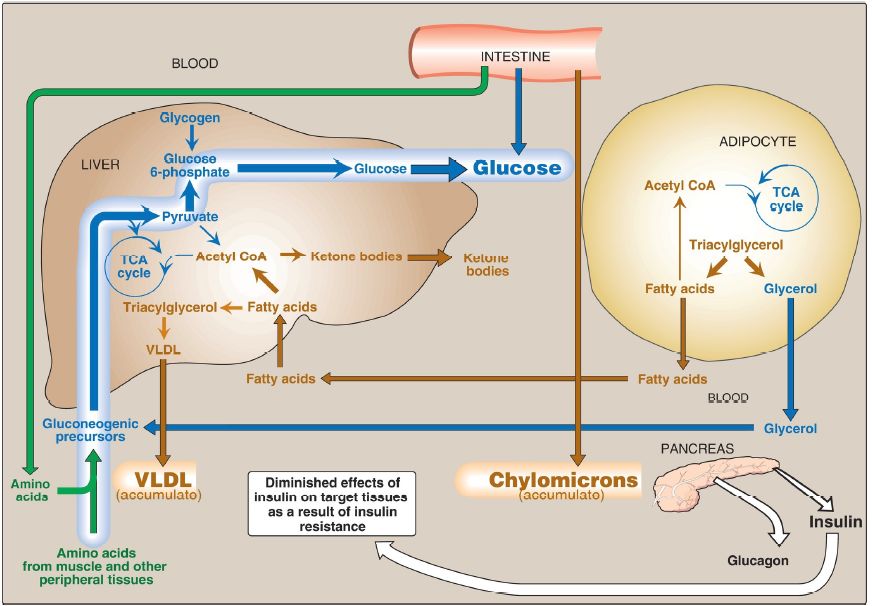


 النبات
النبات
 الحيوان
الحيوان
 الأحياء المجهرية
الأحياء المجهرية
 علم الأمراض
علم الأمراض
 التقانة الإحيائية
التقانة الإحيائية
 التقنية الحيوية المكروبية
التقنية الحيوية المكروبية
 التقنية الحياتية النانوية
التقنية الحياتية النانوية
 علم الأجنة
علم الأجنة
 الأحياء الجزيئي
الأحياء الجزيئي
 علم وظائف الأعضاء
علم وظائف الأعضاء
 الغدد
الغدد
 المضادات الحيوية
المضادات الحيوية|
Read More
Date: 15-9-2021
Date: 15-10-2021
Date: 23-8-2021
|
Metabolic changes of type 2 diabetes (T2D)
The abnormalities of glucose and TAG metabolism in T2D are the result of insulin resistance expressed primarily in liver, skeletal muscle, and white adipose tissue (Fig. 1).

Figure 1: Intertissue relationships in type 2 diabetes. [Note: Ketogenesis is restrained as long as insulin action is adequate.] TCA = tricarboxylic acid; CoA = coenzyme A; VLDL = very-low-density lipoproteins.
1. Hyperglycemia: Hyperglycemia is caused by increased hepatic production of glucose, combined with diminished use of glucose by muscle and adipose tissues. Ketonemia is usually minimal or absent in patients with T2D because the presence of insulin, even in the presence of insulin resistance, restrains hepatic ketogenesis.
2. Dyslipidemia: In the liver, FFA are converted to TAG, which are packaged and secreted in VLDL. Dietary TAG–rich chylomicrons are synthesized and secreted by the intestinal mucosal cells following a meal. Because lipoprotein TAG degradation catalyzed by lipoprotein lipase in adipose tissue is low in diabetes, the plasma chylomicron and VLDL levels are elevated, resulting in hypertriacylglycerolemia (see Fig. 1).
Low levels of high-density lipoproteins are also associated with T2D, likely as a result of increased degradation.



|
|
|
|
التوتر والسرطان.. علماء يحذرون من "صلة خطيرة"
|
|
|
|
|
|
|
مرآة السيارة: مدى دقة عكسها للصورة الصحيحة
|
|
|
|
|
|
|
نحو شراكة وطنية متكاملة.. الأمين العام للعتبة الحسينية يبحث مع وكيل وزارة الخارجية آفاق التعاون المؤسسي
|
|
|